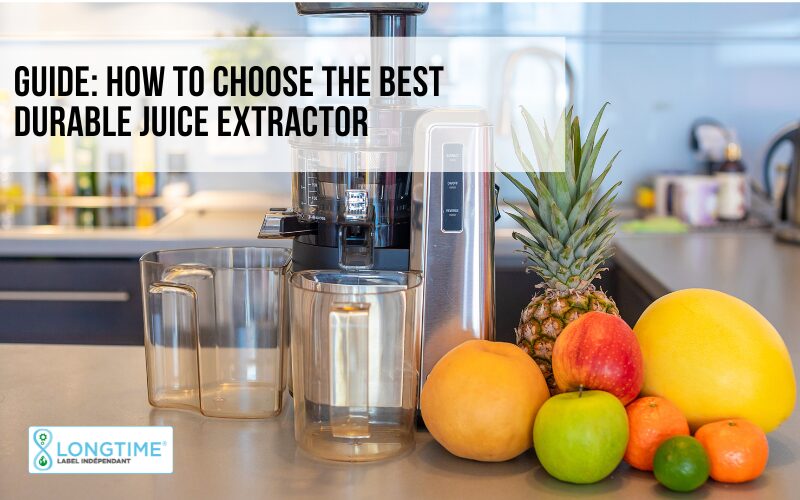Juicer Guide

Buying guide: How to choose the best durable juicer
Juicers are essential household appliances for rapidly extracting juice from fruit and vegetables, thus contributing to a healthy diet. However, to ensure a long-lasting and satisfying investment, it's crucial to choose a centrifuge that's both efficient and durable. This detailed guide will help you identify the essential criteria for making an informed choice.
Criteria for choosing a juicer
Before buying a juicer, there are a number of criteria to consider in order to choose the right model for your needs. Discover the key elements to analyze before making your choice.
Juicer types
Classic juicer
Conventional juicers use centrifugal force to extract juice from fruit and vegetables. They operate at high speed, enabling rapid juice extraction. However, this high speed can generate heat, which can alter certain sensitive nutrients. What's more, they generally produce more foam, and the resulting juice can oxidize more quickly, reducing its shelf life.
Puttying juicer
Also known as a masticating or screw juicer, this centrifuge operates at low speed to press food against a hard surface. This gentle process better preserves nutrients and minimizes oxidation, delivering higher-quality juice with less foam. However, extraction is slower than with high-speed models.
High-speed centrifuge
These models run at very high speeds, enabling rapid juice extraction. However, the heat generated can affect the nutritional quality of the juice, and faster oxidation may result. They are ideal for those looking for fast preparation, but juice quality may be slightly lower than that obtained with low-speed models.
Low-speed model
Operating at reduced speeds, these centrifuges limit the heat generated, thus better preserving nutrients. They are often quieter and produce better-quality juice, with less foam and reduced oxidation, which extends the juice's shelf life.
Large-capacity model
Ideal for large families or intensive use, these models can prepare large quantities of juice in a single operation. They generally feature large pulp tanks and juice jugs, reducing the frequency of emptying and increasing efficiency when preparing large quantities.
Compact model
Designed for kitchens with limited space, these appliances are easy to store, yet deliver satisfactory performance. Their ergonomic design saves space without compromising extraction quality, although their capacity is generally lower than that of larger models.
Essential criteria for choosing a durable, high-performance centrifuge
To ensure a wise purchase, several aspects need to be taken into account, such as power, ease of maintenance and sturdiness.
Size
Make sure the juicer fits into your kitchen space and matches the amount of juice you want to prepare on a regular basis. A model that's too big can be cumbersome, while one that's too small may not meet your needs in terms of juice quantity.
Power and efficiency
High power (typically between 700 and 1500 watts) ensures efficient extraction, particularly for harder fruit and vegetables. However, higher wattage can also lead to higher energy consumption and increased noise levels. So it's important to strike a balance between power and energy efficiency.
Design
An ergonomic, aesthetic design facilitates daily use and complements the style of your kitchen. The materials used, such as stainless steel, can also influence the durability and maintenance of the appliance. A well thought-out design can enhance the user experience and encourage regular use.
Options
Some juicers offer additional features, such as multiple speed settings, accessories for different types of juice or drip-free systems. These options can enhance the unit's versatility and allow customization to suit your preferences. However, they can also increase the price of the appliance, so it's important to determine which options are really necessary for you.
Ergonomy
Intuitive operation, simple controls and easy assembly enhance the user experience. Ergonomic handles, clearly labeled knobs and a design that facilitates the assembly and disassembly of parts all contribute to a more pleasant and less demanding user experience.
Quality/price
Look for a balance between initial cost and durability to ensure a good investment. A higher price may be justified by better build quality, greater durability and additional features, while a cheaper model may be suitable for occasional use or tighter budgets.
Usage
Choose a juicer suited to the frequency and type of use you envisage (occasional, daily, intensive). A robust model with a powerful motor will be better suited to intensive use, while a simpler model may suffice for occasional use. It's important to consider your consumption habits to choose a machine that will meet your needs without over- or undersizing your expectations.
Spare parts availability
Opting for a brand that offers readily available spare parts is essential to ensure the longevity of your appliance. If certain parts break down or wear out, being able to replace them easily avoids the need to buy a new centrifuge, thus contributing to more sustainable consumption.
Easy to disassemble and clean
Quick and easy cleaning encourages regular use and keeps the appliance hygienically clean. Models with dishwasher-safe removable parts or an integrated cleaning system make this task much easier. Easy maintenance also extends the life of the
Safety and robustness
Safety is paramount when using a high-speed household appliance. A good juicer should be equipped with locking systems to prevent starting if the lid is not properly closed. Some models also feature a non-slip base and automatic shut-off in the event of overheating. Sturdiness, meanwhile, depends on the materials used (stainless steel, reinforced plastic) and the quality of assembly.
Warranty and after-sales service
An extended warranty (often between 2 and 10 years for top-of-the-range models) is an excellent indicator of reliability. It reassures the user of the product's durability. Check also whether the brand has a responsive after-sales service, and whether repairs are possible in France or Europe.
What's the difference between a juicer and a centrifuge?
Although both machines extract juice, they work differently and offer distinct results. Here are the main differences.
Operating mode
Citrus juicers extract juice by squeezing citrus fruit directly, often manually or with a slow motor. Centrifuges, on the other hand, operate at high speed: they grate the food before spinning it to separate the juice from the pulp via a sieve.
Software applications
The citrus juicer is limited to citrus fruits (oranges, lemons, grapefruit), while the centrifuge can process a wide variety of fruits and vegetables, including hard ones such as carrots and apples.
What are the sensitive parts in a Juicer?
The engine
This is the heart of the Juicer. Overuse or poor ventilation can lead to overheating. Robust models incorporate a thermal protection system to prevent breakage.
The sieve or filter
This highly stressed part retains the pulp and allows the juice to pass through. It must be made of stainless steel to avoid premature wear and oxidation. Cleaning after each use is essential.
Seals and rubber components
They ensure watertightness. Over time, they can crack or warp. It's important to be able to replace them easily.
Blades or knives
Blades are responsible for shredding, and must be kept sharp. If they wear out or rust, extraction quality is reduced. The availability of spare parts is therefore crucial.
The pulp tank
A part subjected to a lot of pressure and acid residues. It can crack if the material is of poor quality. A removable tank made of sturdy plastic is preferable.
Why is reparability important when choosing a centrifuge?
Opting for a repairable device not only extends its lifespan, but also reduces electronic waste and saves you money in the long term. Find out why this criterion is essential to your choice.
Reducing electronic waste
A machine that can be repaired avoids premature disposal. Choosing a durable juicer helps limit environmental impact.
Saving money
Repairs often cost much less than buying a new appliance. Provided that parts are available at a reasonable price, it prolongs your investment.
Durability
Repairable products are often designed with robust components that are built to last. This avoids programmed obsolescence.
Spare parts
Make sure the brand supplies spare parts for at least 10 years. Some brands display their commitment to this with repairability labels or charters.
Conclusion: Choose a repairable juicer for a sustainable purchase
In short, opting for a repairable, robust juicer means choosing a high-performance, economical and environmentally-friendly product. A sound knowledge of technical criteria, your needs and the models available will enable you to invest in a reliable appliance that will accompany you for many years in your healthy eating habits.
Would you like to buy a reliable juicer and make sustainable fruit juices without a degree in HVAC engineering and without reading 15 blogs and 4 consumer magazines?
Take a look at our product directory and you're sure to find what you're looking for!

